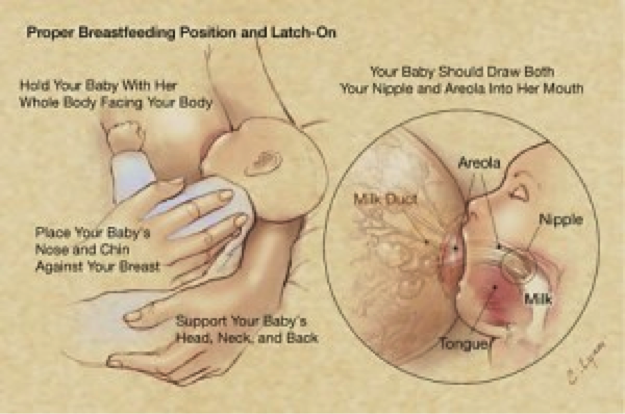BREASTFEEDING
Breast feeding and breast milk is the best gift a mother can give to her baby. It contains all nutrients in the right composition which is easily digestable by your baby and also contains various antibodies, vitamins, amino acids, and minerals. It is well proven that breast fed babies suffer from fewer illnesses, infection and have overall higher intelligence than non breast fed babies. Breastfeeding gives a great sense of satisfaction and increases the bonding between the mother and her baby. Traditionally the knowledge of breastfeeding and technique is transferred across by the mother to her daughter after child birth.
How should I prepare for breastfeeding?
Your body is already getting ready for breastfeeding and that is why the breasts get bigger during pregnancy as the milk ducts and milk-producing cells are developing, and breast gets more blood supply than before.You can buy nursing bras and nursing tops which comes with flaps that open up in the front with easy access to the breast for the baby. Most salespersons in the shop will help you if you ask for them. Nursing pillows, Breast pads are other helpful products to buy. If you have inverted nipple that may need treatment and please consult your doctor.
What is the physiology behind secretion of breastmilk and what can the mother do to improve secretion of breastmilk?
Hormones secreted in the mother called prolactin and oxytoxin along with certain reflexes called milk secretion and milk ejection reflexes help in the secretion of milk by the glands in the breast followed by ejection into the breast ducts. It is important for the mother to be relaxed; and baby stays in contact with the mother and sucks from the breast often for these reflexes to be stronger and improved milk secretion.
When to start breast feeding
You can start breastfeeding within the first half hour of birth. If you had a Caesarian section you will be able to start feeding soon after the surgery in case of a spinal anaesthesia.If you have received a general anaesthesia this will take a little longer. You can inform your wishes to the nurses before delivery and ask for painkillers if you are in pain.
How often to breastfeed in the first few weeks?
Every baby is different and unique. Some newborns may feed every 1.5 hours, while some every 3 hours. Once your milk comes in on an average they feed 8-12 times per 24 hours on your breast.If your baby is not waking up every 3-4 since the last feed try to wake him up by rubbing his feet, patting his back etc. Contact your paediatrician if your baby is not waking up and not interested in feeding despite stimulation
What are the feeding cues/ how do I know my baby is hungry?
If the Whenever your baby shows signs of waking or hunger(Feeding Cues), baby should be put to the breast.The feeding cues are as below
- Mouth opening with sucking and licking movements
- Hand to mouth
- Turning head side to side
- Stretching and increasing physical activity
- If they are very hungry they will start crying and the face will go red
Feeding cues
How do I know my baby is taking enough milk
Typically once the feeding is established baby will
- feed on the breast, feel satisfied and sleep for 2-3 hours before the next feed
- pass urine 4-6 times a day,
- and will be gaining weight.
It is common for mothers to experience difficulty in the first 2-3 days after the birth of your baby but you should remain more positive and try to enjoy the experience of breastfeeding
How Long should I Breastfeed
The world health organization recommends exclusive breastfeeding(Only breastfeeding and not even water) for atleast 6 months. After 6 months you can give complimentary feeding and continue breastfeeding upto the age of 2 years and even beyond
What is the proper technique to breastfeed and what are the different positions
Breastfeeding can be done in any position by the mother as long as she and her baby is comfortable. Make sure babys whole body is supported, babys body turned towards the mother with the head and body are aligned in one line and not twisted. Remember if your baby is feeding too long fore than half an hour to one hour and not calming down after feeding then very likely he is not feeding correctly. You must check with your doctor/nurse the technique(positioning and attachment) of your baby.
The steps involved as below
- Hold your baby in a comfortable position across your chest, or upright sitting on your hip, so that his face is directed toward your breast.
- Support your breast with your free hand when getting him to latch on.
- It may be helpful to express or massage some breast milk down to the nipple for your baby to taste or lick before you get a wide open mouth to latch.
- When he opens wide, bring him quickly but gently towards your breast.
- Do not push your breast towards your baby.
- Your baby’s chin comes first, with the lower lip covering as much of the brown area of the breast, called the areola, as possible.
- The upper lip comes to the breast last.
- Remember –Your baby should not just suckle on the nipple alone because this will cause discomfort and poor milk transfer. Your baby must suck the nipple along with the black circular part around it(areola) for effective breast feeding.
- If your baby has not latched on properly and is causing discomfort, insert your finger into the corner of his mouth through the gums to break the suction and remove him from your breast.
- Reposition and re-latch until you feel comfortable.
- It may take a few moments of initial rapid suckling until you hear your baby start to swallow your milk and then the sucking slows down as he continues to drink your milk.
The following video shows the different positions in which breast feed can be given
Is it better to alternate between two breasts or to complete feeding on one breast and try other breast
The composition of the breastmilk differs from the beginning to the end. At the start of the feeding the foremilk is rich in water , protein, sugar and vitamin which helps to reduce the babys thirst. Towards the last part of feeding the hindmilk contains more fat which provides energy and gives a sense of satisfaction to the baby. Hence it is advisable to feed on one breast completely and go to the next.
How to increase milk supply
It is important for the mother to drink adequate amount of water( about 10-12 glasses everyday), and breastfeed the baby regularly. She also must try to relax and get enough rest as stress can affect the milk letdown reflex which decreases milk secretion. Your doctor can prescribe certain medications to increase milk secretion.
Iam not getting enough milk
It is very common for mothers to feel that their milk secretion is not good in the first few days after birth. This may be true but your newborn baby has enough reserves to meet his/her needs. The first few drops of milk(Colostrum) although less in quantity is very rich in antibodies and is very crucial. It is very important to feel positive and think positively as that will improve milk secretion. Also try to get enough rest in between feeds and try not getting stressed too much which is easier said than done.
What happens if you don’t feed or empty the milk regularly
If you are not regularly breastfeeding or expressing the breast becomes full and heavy. This sends a message to the brain that the milk in not needed anymore and the milk output might reduce.
How I can prepare for breastfeeding and working
If you are planning to return to work and continue breastfeeding it may be possible depending on the nature of your job. The alternative is to express your milk and continue to feed your breast milk. You will need to plan atleast a month in advance if you are planning to express your milk. Once expressed the milk can be stored at room temperature for 6-8 hrs and in the fridge for 24 hours. Once frozen at -20°F the milk can be stored for 3 months. You can hand express or use a breast pump(Manual/electrical). Make sure you follow appropriate sterilization procedures and use appropriate sterilisers in case you are using a bottle, and there is someone trained to look after your baby in advance.
What are the other uses of breast pump
Use of breast pump might help latching easier by softening the breast and relieving breast engorgement and stimulate more milk production. Breast pump also will be helpful to the mother if the baby is preterm or cannot breast feed for some other reason eg., If the baby is on a breathing machine. In such scenarios expressed breast milk can be given via a nasogastric tube if the baby is well enough to be fed.
How can I make a choice whether to buy manual or electric breast pump
| Manual Breast pump | Electric Breast pump |
| · Less expensive 15000-2500 INR· Small and light weight· Advised if you are planning to milk express infrequently Expressing takes longer time and can be tiresome. | · Expensive 4000-10000 INR· Can be heavy and noisy· Advised if you are planning to express regularly for longer time as it is quicker and less tiresome. Suggested if you are planning to return to work |
Storing your expressed breast milk
Does my child need Additional vitamins?
Breast milk provides all the vitamins and minerals your baby needs, except for some vitamins like vitamin D. All breastfed babies need an additional supplement of vitamins.You baby may need Iron and Folic acid supplements in certain situations
Do I need to Supplement my baby with formula?
The first few days after birth is very crucial in establishing breast feeds and most babies will learn to feed quickly and therefore no supplemental feeds are advised. But if the mother cannot breast feed immediately or if it was felt the baby is not getting enough supplementation with formula feed may be needed. We must try to stop this at the earliest possible.
Can I Take medications while breastfeeding?
Most drugs can be transferred to a baby through breast milk. However, most medications that reach the breast milk do so in very small quantities. This means that a baby will receive only tiny amounts of the drug. If you need to take a medication while breastfeeding, check with your doctor to make sure that the medication is compatible with breastfeeding.
For more videos on breast feeding and other useful information please visit https://globalhealthmedia.org
Author:Dr. S. Boopathi, MBBS, MD, DNB Paediatrics (AIIMS), MRCPCH(UK)
![]()





